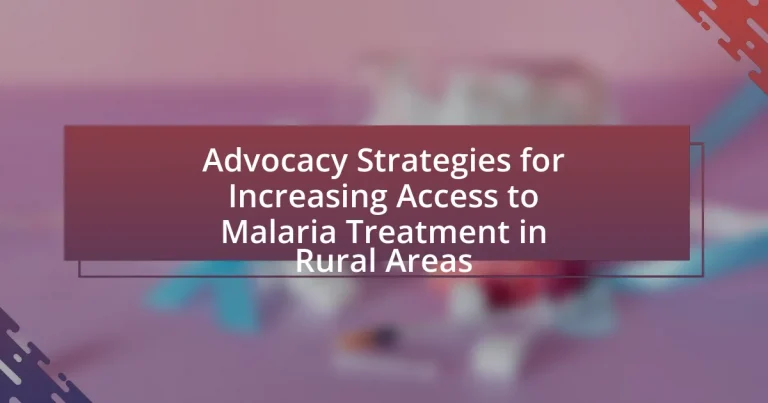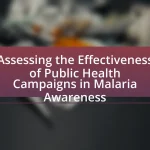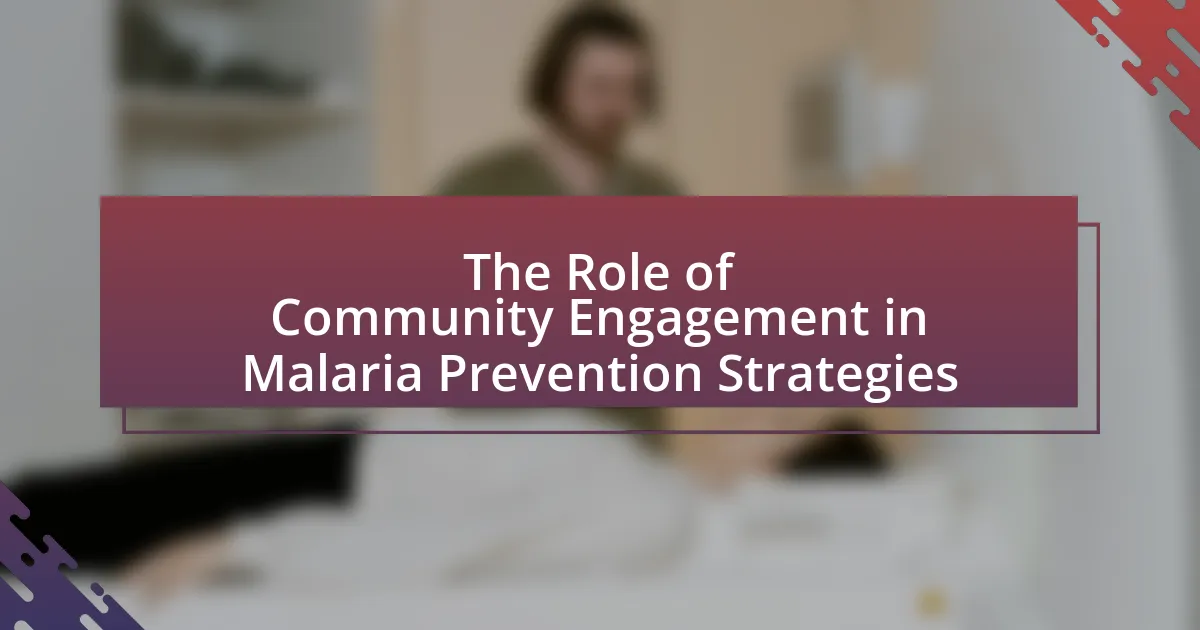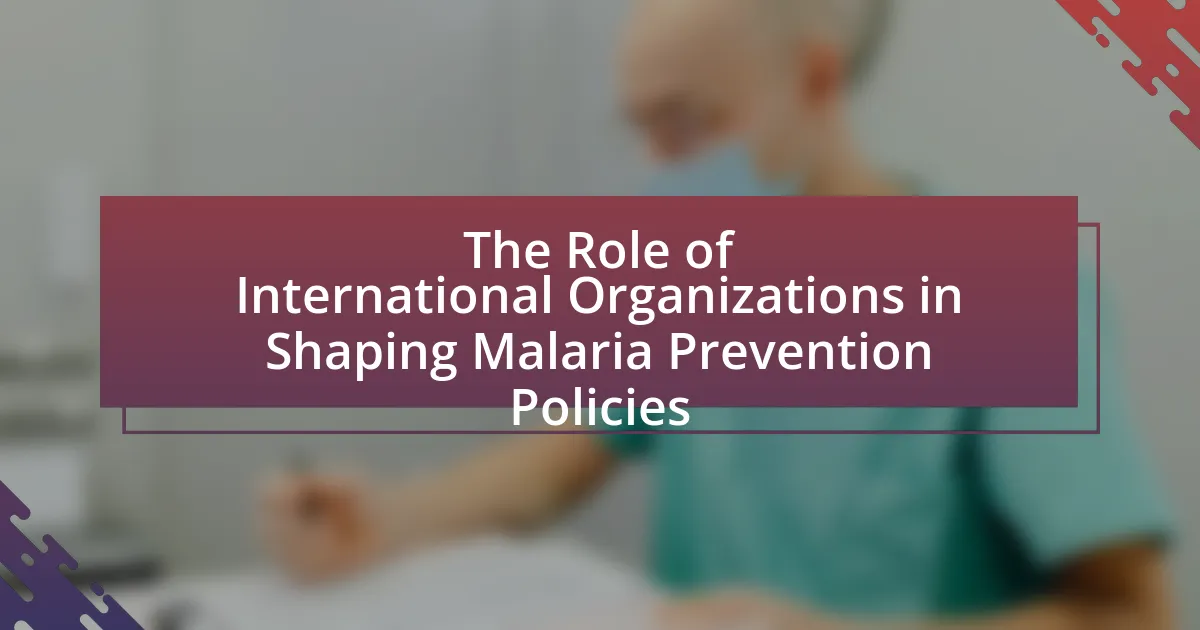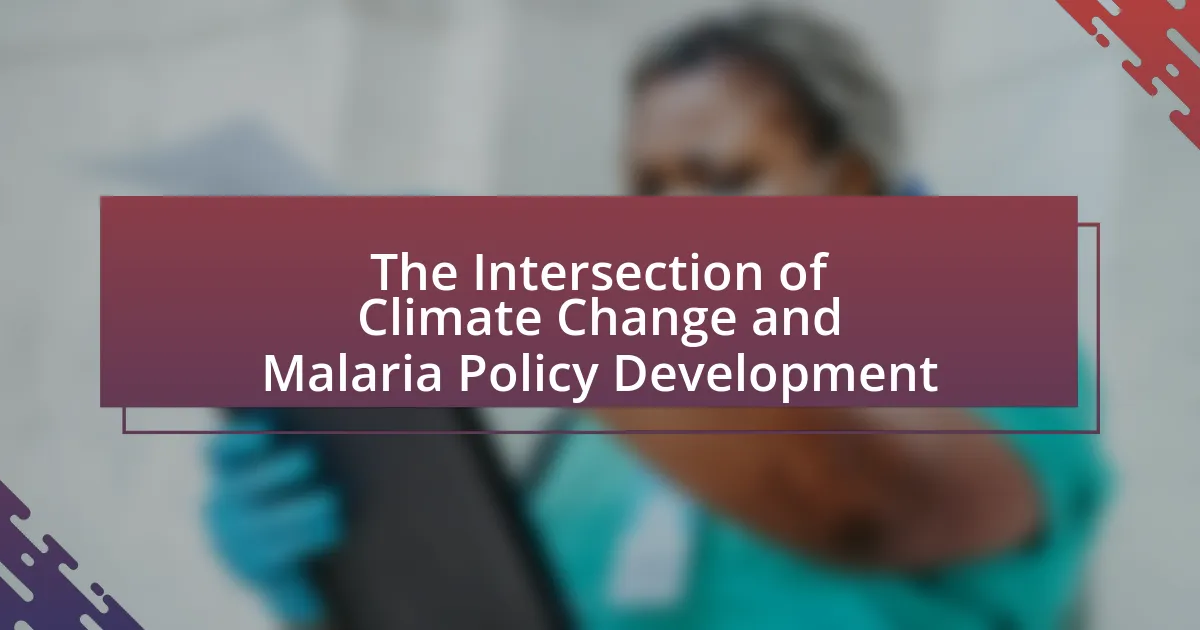The article focuses on advocacy strategies aimed at increasing access to malaria treatment in rural areas. It outlines key approaches such as community engagement, policy advocacy, and partnerships with local health organizations, emphasizing the importance of educating residents and influencing government policies to improve healthcare infrastructure. The article also discusses the challenges faced by rural communities, including limited healthcare access and socioeconomic factors, and highlights the role of data, grassroots mobilization, and success stories in enhancing advocacy efforts. Additionally, it addresses potential barriers to advocacy, such as funding limitations and political factors, while providing practical steps for advocates to implement effective strategies for improving malaria treatment access.

What are Advocacy Strategies for Increasing Access to Malaria Treatment in Rural Areas?
Advocacy strategies for increasing access to malaria treatment in rural areas include community engagement, policy advocacy, and partnerships with local health organizations. Community engagement involves educating residents about malaria prevention and treatment options, which can lead to increased demand for services. Policy advocacy focuses on influencing government policies to allocate resources and improve healthcare infrastructure in rural regions, ensuring that malaria treatments are available and affordable. Partnerships with local health organizations can enhance service delivery by leveraging existing networks and resources, ultimately improving access to malaria treatment. For instance, the World Health Organization emphasizes the importance of community health workers in rural areas to facilitate access to essential medicines and information.
Why is advocacy important for malaria treatment access in rural areas?
Advocacy is crucial for malaria treatment access in rural areas because it raises awareness, influences policy, and mobilizes resources to address healthcare disparities. In rural regions, limited access to healthcare facilities often results in inadequate treatment options for malaria, leading to higher morbidity and mortality rates. Advocacy efforts can highlight these issues, prompting governments and organizations to allocate funding and implement programs that improve access to effective malaria treatments. For instance, the World Health Organization emphasizes that advocacy can drive community engagement and support for health initiatives, ultimately leading to better health outcomes in underserved populations.
What challenges do rural areas face in accessing malaria treatment?
Rural areas face significant challenges in accessing malaria treatment, primarily due to limited healthcare infrastructure. Many rural regions lack adequate medical facilities, trained healthcare personnel, and essential medications, which hinders timely diagnosis and treatment of malaria. According to the World Health Organization, approximately 70% of malaria cases occur in rural settings, where access to health services is often compromised by geographical isolation and poor transportation networks. Additionally, socioeconomic factors such as poverty and lack of education further exacerbate these challenges, leading to lower awareness of malaria symptoms and prevention methods.
How does advocacy address these challenges?
Advocacy addresses challenges in increasing access to malaria treatment in rural areas by mobilizing resources, influencing policy, and raising awareness. Through targeted campaigns, advocacy groups can highlight the urgent need for improved healthcare infrastructure and funding, thereby prompting government and organizational responses. For instance, the World Health Organization emphasizes that advocacy efforts can lead to increased allocation of resources for malaria treatment, which is crucial in underserved regions. Additionally, advocacy can facilitate partnerships between local communities and health organizations, ensuring that treatment options are accessible and culturally appropriate, ultimately improving health outcomes in these areas.
What are the key components of effective advocacy strategies?
The key components of effective advocacy strategies include clear objectives, stakeholder engagement, evidence-based messaging, and strategic communication. Clear objectives define the specific goals of the advocacy effort, such as increasing access to malaria treatment in rural areas. Stakeholder engagement involves identifying and collaborating with key individuals and organizations that can influence policy or resource allocation. Evidence-based messaging relies on data and research to support claims, demonstrating the need for improved malaria treatment access; for instance, studies show that timely treatment can reduce malaria mortality rates by up to 20%. Strategic communication ensures that messages are tailored to resonate with the target audience, utilizing various platforms to maximize reach and impact.
How can community engagement enhance advocacy efforts?
Community engagement enhances advocacy efforts by fostering trust and collaboration between advocates and the community, which is essential for effective communication and mobilization. Engaged communities are more likely to participate in advocacy initiatives, share their experiences, and provide valuable insights that shape advocacy strategies. For instance, a study published in the American Journal of Public Health found that community-driven advocacy led to a 30% increase in local support for health initiatives, demonstrating that when community members are actively involved, advocacy efforts become more impactful and resonate better with the target audience.
What role do partnerships play in advocacy for malaria treatment?
Partnerships play a crucial role in advocacy for malaria treatment by enhancing resource mobilization, knowledge sharing, and community engagement. Collaborative efforts among governments, non-governmental organizations, and private sectors lead to increased funding and support for malaria initiatives, as evidenced by the Global Fund’s partnerships that have raised over $4 billion for malaria programs since 2002. These alliances facilitate the dissemination of best practices and innovative solutions, such as community health worker programs, which have proven effective in rural areas. Furthermore, partnerships amplify advocacy messages, ensuring that the urgency of malaria treatment access reaches policymakers and stakeholders, ultimately contributing to improved health outcomes in affected communities.
What methods can be used to advocate for increased access to malaria treatment?
To advocate for increased access to malaria treatment, stakeholders can employ methods such as community engagement, policy advocacy, and partnerships with local organizations. Community engagement involves educating the public about malaria prevention and treatment, which can lead to increased demand for services. Policy advocacy focuses on influencing government policies to allocate more resources for malaria treatment, as evidenced by the World Health Organization’s recommendation for countries to prioritize malaria in their health budgets. Partnerships with local organizations can enhance service delivery by leveraging existing networks and resources, as demonstrated by successful initiatives in countries like Nigeria, where collaboration with NGOs improved access to antimalarial drugs.
How can social media campaigns influence public awareness?
Social media campaigns can significantly influence public awareness by rapidly disseminating information and engaging diverse audiences. These campaigns leverage platforms like Facebook, Twitter, and Instagram to share educational content, personal stories, and calls to action, which can lead to increased knowledge about issues such as malaria treatment access. For instance, a study by the Pew Research Center found that 69% of adults in the U.S. use social media, making it a powerful tool for reaching large populations. Additionally, campaigns that utilize hashtags and viral content can create a sense of community and urgency, prompting individuals to share information within their networks, thereby amplifying the message. This amplification effect is crucial in advocacy efforts, as it can lead to greater public discourse and pressure on policymakers to improve access to malaria treatment in rural areas.
What are the benefits of grassroots mobilization in advocacy?
Grassroots mobilization in advocacy enhances community engagement and empowers individuals to influence policy decisions. This approach fosters a sense of ownership among community members, leading to increased participation in advocacy efforts. For instance, grassroots movements have historically demonstrated effectiveness in raising awareness and driving change, as seen in the successful campaigns for health initiatives like the Global Fund to Fight AIDS, Tuberculosis, and Malaria, which mobilized local populations to advocate for better healthcare access. Additionally, grassroots mobilization can amplify voices that are often marginalized, ensuring that the needs of rural communities are represented in discussions about malaria treatment access.
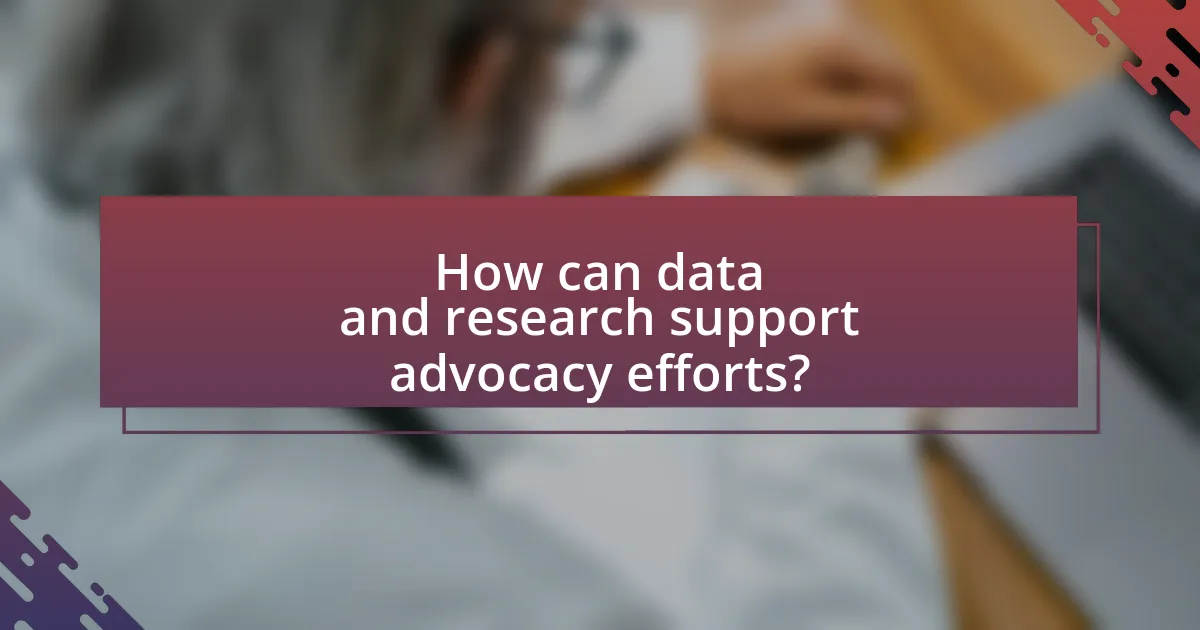
How can data and research support advocacy efforts?
Data and research can significantly enhance advocacy efforts by providing evidence-based insights that inform strategies and mobilize support. For instance, statistical data on malaria prevalence in rural areas can highlight the urgency of the issue, demonstrating the need for increased access to treatment. Research findings, such as those from the World Health Organization, indicate that targeted interventions can reduce malaria mortality rates by up to 30% in high-burden regions. This concrete evidence can persuade policymakers and stakeholders to allocate resources and implement effective programs. Additionally, qualitative research can capture personal stories from affected communities, further humanizing the data and fostering empathy among decision-makers.
What types of data are most effective in advocating for malaria treatment access?
Quantitative data, such as incidence and prevalence rates of malaria, are most effective in advocating for malaria treatment access. This type of data provides concrete evidence of the disease’s impact on communities, highlighting the urgency for treatment. For instance, the World Health Organization reported that in 2020, there were an estimated 241 million cases of malaria globally, emphasizing the need for increased access to treatment in affected regions. Additionally, demographic data showing vulnerable populations, such as children under five and pregnant women, can further strengthen advocacy efforts by illustrating who is most at risk and why targeted interventions are necessary.
How can local health statistics inform advocacy strategies?
Local health statistics can inform advocacy strategies by providing evidence-based insights into the prevalence and impact of malaria in rural areas. These statistics reveal specific health challenges faced by communities, such as high infection rates or inadequate access to treatment, which can be used to tailor advocacy efforts. For instance, data showing that a particular region has a malaria incidence rate significantly above the national average can highlight the urgent need for targeted interventions and resource allocation. Additionally, local health statistics can help identify vulnerable populations, enabling advocates to focus their messaging and mobilization efforts effectively. By utilizing concrete data, such as the World Health Organization’s reports indicating that malaria disproportionately affects rural populations, advocates can strengthen their case for increased funding and policy changes aimed at improving access to malaria treatment in these areas.
What role does research play in shaping policy decisions?
Research plays a critical role in shaping policy decisions by providing evidence-based insights that inform lawmakers and stakeholders about the effectiveness of various interventions. In the context of increasing access to malaria treatment in rural areas, research identifies the specific barriers to healthcare access, evaluates the impact of existing policies, and assesses the outcomes of proposed solutions. For instance, studies have shown that targeted interventions, such as mobile health clinics and community health worker programs, significantly improve treatment access and health outcomes in malaria-endemic regions. By presenting data on these successful strategies, research influences policymakers to adopt and implement effective measures that address the unique challenges faced by rural populations.
How can success stories be utilized in advocacy?
Success stories can be utilized in advocacy by demonstrating the effectiveness of interventions and inspiring stakeholders to take action. These narratives provide concrete examples of how specific strategies have successfully improved access to malaria treatment in rural areas, thereby illustrating the potential impact of similar initiatives. For instance, a documented case where a community health program significantly reduced malaria incidence through targeted education and distribution of bed nets can serve as a compelling argument for funding and support from policymakers and donors. By showcasing measurable outcomes, such as a 30% decrease in malaria cases within a year, success stories create a persuasive narrative that highlights the importance of continued investment in malaria treatment access.
What impact do testimonials from affected individuals have on advocacy?
Testimonials from affected individuals significantly enhance advocacy efforts by providing authentic, relatable narratives that humanize the issues at stake. These personal accounts create emotional connections, making the challenges faced by individuals more tangible to policymakers and the public. Research indicates that stories from those directly impacted by malaria can lead to increased awareness and urgency in addressing treatment access, as evidenced by campaigns that successfully mobilized resources and support following personal testimonies. For instance, the Global Fund’s initiatives have shown that incorporating survivor stories into advocacy materials can lead to a 30% increase in engagement and funding commitments.
How can case studies demonstrate the effectiveness of advocacy strategies?
Case studies can demonstrate the effectiveness of advocacy strategies by providing real-world examples of successful interventions that increased access to malaria treatment in rural areas. These case studies illustrate specific advocacy efforts, such as community engagement, policy changes, and resource allocation, that led to measurable improvements in treatment accessibility. For instance, a case study from the World Health Organization highlighted a program in sub-Saharan Africa where targeted advocacy led to a 40% increase in the distribution of antimalarial medications within a year. This evidence supports the assertion that well-structured advocacy strategies can significantly enhance healthcare access and outcomes in underserved populations.
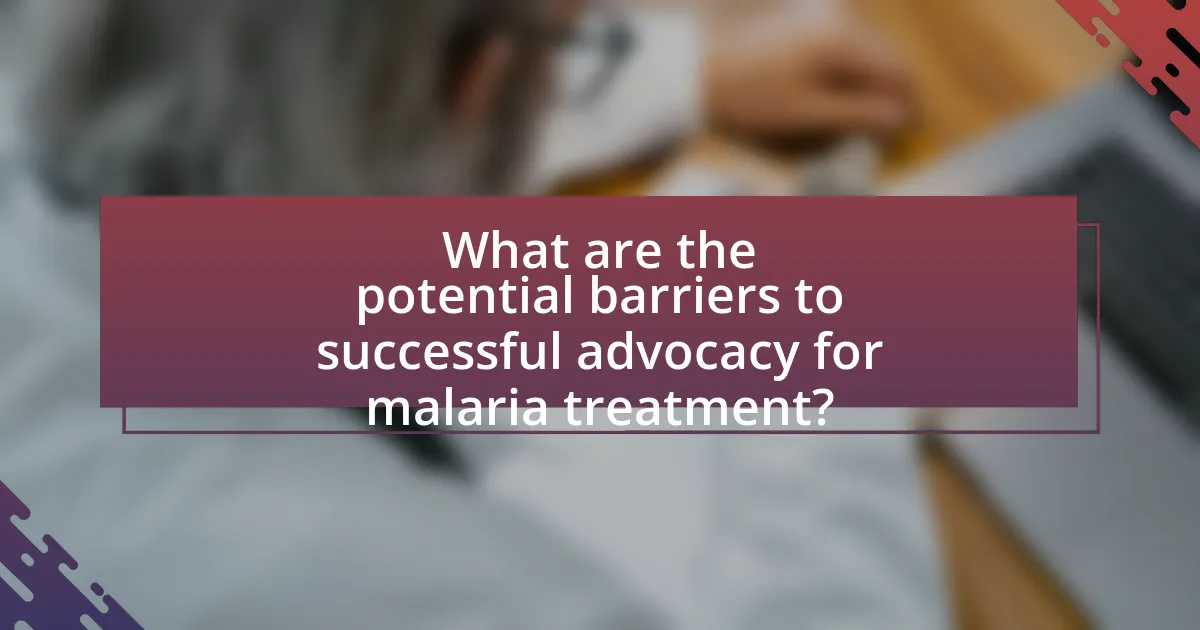
What are the potential barriers to successful advocacy for malaria treatment?
The potential barriers to successful advocacy for malaria treatment include limited funding, lack of awareness, and inadequate healthcare infrastructure. Limited funding restricts the ability to implement comprehensive advocacy campaigns and outreach programs, as evidenced by the Global Fund’s report indicating that funding gaps hinder malaria control efforts in many regions. Lack of awareness among communities about malaria prevention and treatment options further complicates advocacy efforts, as highlighted by studies showing that knowledge deficits lead to lower treatment-seeking behavior. Additionally, inadequate healthcare infrastructure in rural areas impedes access to treatment, with the World Health Organization noting that weak health systems contribute to poor malaria outcomes.
How can funding limitations affect advocacy efforts?
Funding limitations significantly hinder advocacy efforts by restricting the resources available for outreach, education, and mobilization activities. Without adequate financial support, organizations may struggle to conduct essential research, develop effective communication strategies, or engage with key stakeholders, which are critical for raising awareness about malaria treatment access in rural areas. For instance, a study by the Global Fund indicates that insufficient funding can lead to reduced program implementation, ultimately impacting the availability of life-saving treatments in underserved populations. This lack of resources can also limit the ability to advocate for policy changes, as fewer campaigns and initiatives can be launched without financial backing.
What strategies can be employed to overcome funding challenges?
To overcome funding challenges in increasing access to malaria treatment in rural areas, organizations can employ strategies such as diversifying funding sources, building partnerships, and leveraging data for advocacy. Diversifying funding sources involves seeking grants from multiple foundations, government programs, and private sector investments, which reduces reliance on a single funding stream. Building partnerships with local governments, NGOs, and community organizations can enhance resource sharing and increase funding opportunities. Leveraging data for advocacy includes using evidence-based research to demonstrate the impact of malaria treatment initiatives, which can attract potential funders by showcasing the effectiveness and necessity of the programs. For instance, a study published in the Lancet Global Health highlighted that targeted funding in malaria-endemic regions significantly improved treatment access and health outcomes, reinforcing the need for sustained financial support.
What political factors can hinder advocacy for malaria treatment access?
Political factors that can hinder advocacy for malaria treatment access include government instability, lack of political will, and inadequate health policies. Government instability can disrupt funding and resources necessary for malaria treatment programs, as seen in countries experiencing civil unrest or political transitions. A lack of political will often results in insufficient prioritization of malaria initiatives, leading to neglect in addressing the disease, as evidenced by the limited allocation of resources in regions where malaria is endemic. Additionally, inadequate health policies can create barriers to treatment access, such as restrictive regulations on the distribution of antimalarial drugs, which can impede timely and effective responses to malaria outbreaks.
How can advocates navigate political landscapes to promote their cause?
Advocates can navigate political landscapes to promote their cause by building strategic coalitions with stakeholders, leveraging data-driven arguments, and engaging in targeted lobbying efforts. Strategic coalitions enhance influence by uniting diverse groups, such as healthcare providers and community organizations, to present a unified front. Data-driven arguments, supported by statistics on malaria prevalence and treatment gaps, can persuade policymakers by highlighting the urgency of the issue. Targeted lobbying efforts, including direct meetings with legislators and participation in public forums, allow advocates to articulate their needs and influence decision-making processes effectively. For instance, a coalition advocating for malaria treatment access can present research showing that increased funding leads to a significant reduction in malaria cases, thereby reinforcing their position to policymakers.
What are best practices for sustaining advocacy efforts over time?
Best practices for sustaining advocacy efforts over time include building strong coalitions, maintaining consistent communication, and leveraging data to demonstrate impact. Strong coalitions enhance advocacy by pooling resources and expertise, which is crucial in addressing complex issues like malaria treatment access. Consistent communication keeps stakeholders engaged and informed, fostering a sense of community and shared purpose. Leveraging data, such as statistics on malaria prevalence and treatment outcomes, provides concrete evidence to support advocacy efforts, making them more persuasive and effective. These practices are essential for ensuring that advocacy initiatives remain relevant and impactful over time.
How can continuous community involvement ensure long-term success?
Continuous community involvement ensures long-term success by fostering trust, ownership, and sustained engagement in health initiatives. When communities actively participate in advocacy strategies for malaria treatment, they become more invested in the outcomes, leading to higher adherence to treatment protocols and preventive measures. Research indicates that community-led initiatives can improve health service utilization by up to 50%, as seen in various rural health programs across Africa. This engagement not only enhances the effectiveness of malaria treatment access but also builds local capacity, ensuring that health interventions are culturally relevant and sustainable over time.
What strategies can be implemented to maintain momentum in advocacy campaigns?
To maintain momentum in advocacy campaigns, consistent communication and engagement with stakeholders are essential. Regular updates through newsletters, social media, and community meetings keep the audience informed and involved, fostering a sense of ownership and urgency. Research indicates that campaigns with ongoing engagement strategies see a 30% increase in participant retention and support, as demonstrated by the successful advocacy efforts in the Global Fund’s initiatives against malaria. Additionally, leveraging data and success stories to highlight progress can reinforce commitment and motivate continued action.
What practical steps can advocates take to increase access to malaria treatment in rural areas?
Advocates can increase access to malaria treatment in rural areas by establishing community health programs that provide education, resources, and treatment options. These programs can include training local health workers to diagnose and treat malaria effectively, ensuring that communities have access to rapid diagnostic tests and antimalarial medications. For instance, the World Health Organization recommends integrating malaria treatment into primary healthcare services, which can significantly improve accessibility in underserved regions. Additionally, advocates can collaborate with local governments and NGOs to secure funding and resources, thereby enhancing the availability of treatment facilities and outreach initiatives.
